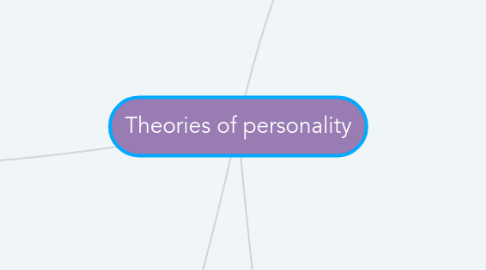
1. Social-cognitive
1.1. Albert Bandura’s Self-system Proposes that the behaviors that define one’s personality are a product of a person’s self- system
1.1.1. For example , A student who feels confident that she will be able to learn the information and do well on a test.
1.2. Julian Rotte locus of Control Locus of control refers to a person’s perception of the extent to which he controls what happens to him.
1.2.1. For example, students with an internal locus of control might blame poor grades on their failure to study, whereas students with an external locus of control may blame an unfair teacher or test for their poor performance.
2. Trait
2.1. Hans Eysenck
2.1.1. Eysenck’s three-factor theory
2.1.1.1. Psychoticism–impulse control trait dimension is concerned with aggressiveness, impulsiveness, empathy (seeing situations from other people’s perspectives), and antisocial behavior.
2.1.1.2. Extraverts are gregarious, outgoing people with lots of friends
2.1.1.3. Introverts are those who are quiet , are more introspective, and tend to avoid social interaction.
2.2. Robert McCrae and Paul Costa ( Five Factor Model)
2.2.1. openness - High: independent, imaginative, broad interests, receptive to new ideas Low: conforming, practical, narrow interests, closed to new ideas
2.2.2. neuroticism- High: emotional, insecure, nervous, self-pitying Low: calm, secure, relaxed, self-satisfied
2.2.3. extraversion- High: sociable, talkative, friendly, adventurous Low: reclusive , quiet, aloof, cautious
2.2.4. conscientiousness- High: well-organized, dependable, careful, disciplined Low: disorganized, undependable , careless, impulsive
2.2.5. Agreeableness - High: sympathetic, polite, good-natured, soft-hearted Low: tough-minded, rude, irritable, ruthless
3. Humanistic
3.1. Carl Rogers’s Self Theory led to another influential style of psychotherapy, client-centered (or person-centered) therapy
3.1.1. conditions of worth the behaviors and attitudes for which they will give us positive regard
3.1.2. Unconditional positive regard acceptance and approval without conditions.
3.2. Abraham Maslow Centers on the positive motivations for our actions and development, especially personal growth
3.2.1. Maslow’s Hierarchy of Needs
3.2.1.1. Physiological needs these are biological requirements for human survival, e.g. air, food, drink, shelter, clothing, warmth, sex, sleep.
3.2.1.2. Safety needs the needs for security and safety become salient
3.2.1.3. Love and belongingness needs The need for interpersonal relationships motivates behavior
3.2.1.4. Love and belongingness needs The need for interpersonal relationships motivates behavior
3.2.1.5. Esteem needs the desire for reputation or respect from others (e.g., status, prestige).
3.3. Self-actualization needs refer to the realization of a person's potential, self-fulfillment, seeking personal growth and peak experiences.
4. Psychoanalytic
4.1. Carl Jung Proposed two main personality attitudes And proposed four functions (or cognitive styles)
4.1.1. Inferiority complex: describe the strong feelings felt by those who never overcome the initial feeling of inferiority.
4.1.1.1. Lead to: feelings of worthlessness and a mistrust of others.
4.1.2. Introversion toward the inner, subjective world
4.1.3. (cognitive styles)
4.1.3.1. sensing and intuiting for gathering information
4.1.3.2. thinking and feeling for evaluating information
4.1.4. Extraversion People’s attitudes focus them toward the external, objective world
4.2. Karen Horney Focus was on dealing with our need for security (Three neurotic personality patterns)
4.2.1. moving away from people : detached, aloof person.
4.2.1.1. moving against people: aggressive, domineering person
4.2.2. moving toward people: compliant, submissive person
4.3. Alfred Adler’s Focus on “striving for superiority,”
4.3.1. Which is the need to overcome the sense of inferiority that we feel as infants, given our totally helpless and dependent state.
4.3.1.1. Superiority complex- an exaggerated opinion of one’s abilities.
4.3.1.1.1. Lead to: a self-centered, vain person
4.4. Sigmund Freud State that sex was a primary cause of emotional Problems
4.4.1. Different levels of awareness
4.4.1.1. Unconscious mind Can not freely access
4.4.1.2. Preconscious mind Not presently aware of but can gain access (long term memory)
4.4.1.3. Conscious mind What presently aware( short term memory)
4.4.2. Dynamic interplay between the three parts of personality
4.4.2.1. Ego Act on reality principle: Finding gratification for instinctual drives within the constraints of reailty
4.4.2.2. ID Act on pleasure principle: Seeking immediate gratification for instinctual Drives without concern for the consequences
4.4.2.3. Superago Act on morality principle: Represent one’s conscience and idealized standard of behavior
4.4.3. Psychology stage theory of personality development
4.4.3.1. Oral stage From birth to 18 months Erogenous zone Mouth,lips,tongue
4.4.3.1.1. Activity focus Sucking,biting and chewing
4.4.3.2. Anal stage From 18 months to 3 years Erogenous zone Anus
4.4.3.2.1. Activity focus Bowel retention and elimination
4.4.3.3. Phallic stage From 3 to 6 years Erogenous zone Genital
4.4.3.3.1. Activity focus Genital stimulation Attraction to opposite-sex parent and identifying with same-sex parent to learn gender role
4.4.3.4. Latency stage From 6 to puberty No Erogenous zone
4.4.3.4.1. Activity focus Cognitive and social development
4.4.3.5. Genital stage From puberty through adulthood Erogenous zone Genital
4.4.3.5.1. Activity focus Development of sexual relationships
